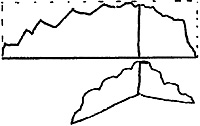The recent arrival of Cross of Iron and Panzerknacker rules in the post from our editor was something of an inspiration for me. For some time now the level at which I game has been steadily decreasing (from the adult to the infantile some might say) with what were Regiments becoming Battalions and now Companies. The small unit nature of the above are very much the next logical step.
Within 24 hours I had planned my first scenario based on two cut off German sections attempting to cross back to their lines through a Russian held built up area. I had lots of scale buildings for the period, but wanted to represent large areas of the table as semi-destroyed, with relevant amounts of rubble and remains of buildings. My keenness presented me with a problem, with only a couple of days to go before the game commercial buildings were out of the question, so I decided to make my own.
Actually this was not as daunting as it sounds, I had already scratched some wrecked structures for my SCW set up, and the same method of construction was used now. The result was lots of cheap and effective wargames buildings with lots of room to move figures.
The materials needed are as follows.
- 1. One sheet of artists mounting board
2. A pair of scissors
3. Superglue
4. Copydex
5. Polyfira or similar
6. A box of matches
7. Basetex
8. Paints (figure paints are fine).
A good starting point is the basic standing corner. Size will depend on the scale figures you are using, let you eye be the best judge.
 1. Mark out the basic shape on your mounting board
1. Mark out the basic shape on your mounting board
2. Cut out with scissors, leaving two sections. Superglue these together like so.
3. Leave to set for a quarter of an hour. Cut out a suitable base, allowing a little space for rubble. Once again use Superglue to attach to walls.
4. Once the Superglue is set coat the model with Copydex. This will strengthen the model and provide a good surface for the Polyfira to key on to.
5. Mix the Polyfira to the consistency of plaster, a fairly stiff porridge is probably the closest thing. Apply to the building with a suitable tool I use a butter knife but I don't tell the wife. Do this tidily, but don't spend too long on it, a perfect finish will look disappointing later. Allow to set, probably overnight, but this can be accelerated in a low oven.
6. Paint your model. Wash the whole thing in watered down Leather or Chestnut brown. Allow this to dry before brushing with a mix of yellow and white. This should be halfway between a dry brush and a wet brush, leaving some brown showing but not too much. Finally brush over with white, this can be done pretty much immediately so the colours blend in together. Try to leave the brown showing where the brickwork would be exposed at the edges.
7. Once dry use the Basetex to decorate the base, I use a dirty brown colour.
To all intents and purposes the model is finished, but a bit of effort now can pay dividends. The Internet is full of period posters that you can download and print off in any size you want. A loose shutter hanging ftom the remains of a window or chaffed roof timbers (those matches) can turn something basic into a "miniature masterpiece" ( well nearly ).
Once this basic model has been mastered something a bit more basic can be tried; building facades left standing, chimney stacks, or even entire street frontages look great. My favourite is a largish industrial chimney with the name of the works painted on it, for about 10p in cost it looks top.
Talking of cost one sheet of mounting board allowed me to cover about nine square foot, with a total cost of about a fiver. Okay I had the Copydex, Superglue, paints and matches on board already, but compare that with something in resin or plastic!
To blend the model together on the tabletop I scatter gritty sharp sand around, this is the advantage of using a cloth as a base rather than expensive terrain boards. All in all a cheap and cheerful project that really gave us the feel of a devastated Europe in 1945.
Back to The Gauntlet No. 19 Table of Contents
Back to The Gauntlet List of Issues
Back to Master Magazine List
© Copyright 2000 by Craig Martelle Publications
This article appears in MagWeb (Magazine Web) on the Internet World Wide Web.
Other military history articles and gaming articles are available at http://www.magweb.com